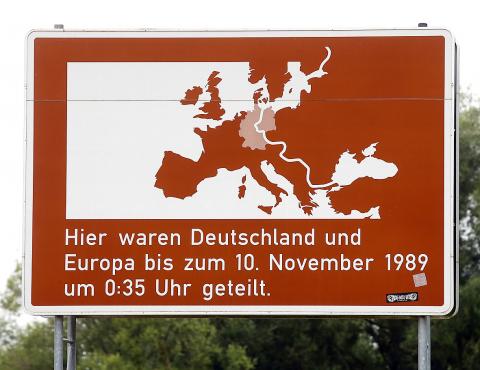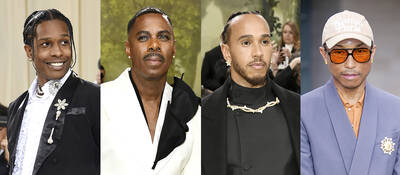Nov. 9 marked the 30th anniversary of the fall of the Berlin Wall, an iconic physical representation of the Iron Curtain. The event led to the reunification of East and West Germany and the eventual collapse of the communist regimes in the Soviet Union and Eastern Europe.
The Iron Curtain was an ideological and physical separation of communist Eastern Europe from the West following World War II.
The term “iron curtain” was popularized after it was used by former British prime minister Winston Churchill in a landmark speech in the US in March 1946. “From Stettin [now called Szczecin] in the Baltic to Trieste in the Adriatic, an iron curtain has descended across the continent,” declared Churchill, then leader of the opposition Conservatives. His comments were seen as an opening salvo in the Cold War that pitted the Soviet Union and the West against each other for more than four decades.

Photo: AFP
照片:法新社
The term had been coined earlier. Russian writer Vasily Rozanov, in his 1918 book The Apocalypse of Our Time, wrote “an iron curtain is being lowered, creaking and squeaking, at the end of Russian history.”
The ideological barrier between Soviet-controlled Eastern Europe and the West gradually became a physical one spanning thousands of kilometers. To stop citizens from fleeing to the West, Soviet-dominated Eastern European countries began erecting various forms of barriers using barbed-wire, ditches and concrete walls. The separations were controlled by alarms, watchtowers, mines and soldiers.
Socialist Hungary put up the first section in 1949, building a 260km barbed wire fence along its border with Austria.

Photo: Reuters
照片:路透
The Berlin Wall was an icon of the Iron Curtain. In 1952 Soviet-satellite East Germany constructed a 10m-wide barbed wire buffer along the entire length of its border with West Germany.
However, people were still able to get across in the divided city of Berlin, with about 3 million fleeing the East via this route between 1952 and 1961. To stop this important loss of manpower, East Germany in 1961 began constructing a wall. Made of reinforced concrete and wire mesh, the Berlin Wall stretched for 155km.
Eastern European citizens were only allowed to visit the West under strict conditions and those who tried to cross over without permission did so at great risk. About 600-700 people died trying to escape East Germany, about 140 at the Berlin Wall.
The first crack in the Iron Curtain appeared in May 1989 when Hungary decided to start opening its border with Austria. On Aug. 19 the frontier was to be symbolically opened for a few hours for a Pan-European Picnic. More than 600 East Germans holidaying in Hungary took advantage and fled to the West. It was the first mass exodus since the 1961 construction of the Berlin Wall.
Soon afterwards Eastern Europe’s communist regimes started to tumble.
East Germans began to demonstrate, and on Nov. 9, 1989 the regime unexpectedly granted them the right to travel to the West freely. Thousands flocked to the wall, and disoriented border guards opened the checkpoints. Throughout the night, euphoric Berliners celebrated. Perching on the wall, they used pickaxes to knock out chunks.
Within two years the Soviet Union had imploded; the Iron Curtain falling with it.
(AFP with staff writer)
十一月九日是柏林圍牆倒塌三十週年。作為最有代表性的具象化鐵幕,柏林圍牆的倒下不但揭開了東西德統一的序幕,最後更導致蘇聯及東歐共產主義政府的瓦解。
「鐵幕」是第二次世界大戰後,共產主義東歐與西方在意識型態上和實際上的分隔。
「iron curtain」(鐵幕)一詞被廣泛使用,是由於前英國首相溫斯頓‧邱吉爾一九四六年三月在美國發表的一場具里程碑意義的演說。時任英國反對黨領袖的保守黨黨魁邱吉爾說道:「從波羅的海的斯德丁〔現稱斯塞新〕到亞得里亞海的第里雅斯特,鐵幕橫跨〔歐洲〕大陸垂降下來」。邱吉爾此語被認為是冷戰的開場白,開啟此後四十多年蘇聯和西方之間的冷戰對抗。
「鐵幕」一詞之杜撰其實還要更早些。俄羅斯作家瓦西里‧羅札諾夫在他一九一八年的書《我們時代的啟示》中寫道:「鐵幕正被降下,在俄羅斯歷史的盡頭嘎吱嘎吱尖聲作響」。
蘇聯控制的東歐跟西方之間的意識型態隔閡,逐漸成為橫跨數千公里的實體分界。被蘇聯支配的東歐國家為阻擋其國民逃向西方,開始用鐵絲網、壕溝和水泥牆架設各種形式的屏障,並以警鈴、瞭望塔、地雷和士兵戒備。
這分隔首次築起是在一九四九年,匈牙利社會主義政權在與奧地利的邊界架起了兩百六十公里長的鐵絲網藩籬。
柏林圍牆是鐵幕的代表。一九五二年,蘇聯的附庸國東德,沿著與西德間的整條邊界建造了十公尺寬的刺網緩衝帶。
但人們還是可以穿越分裂的柏林市──在一九五二年到一九六一年之間,大約有三百萬人經由此路線逃離東柏林。為阻止這嚴重的人力流失,東德於一九六一年開始建造隔離牆。柏林圍牆由鋼筋混凝土和金屬絲網所築成,長達一百五十五公里。
東歐公民必須符合嚴格的條件才能夠造訪西方,未獲許可而試圖越境的人則冒了很大的風險。大約有六百至七百人因試圖逃離東德而死,約一百四十人死於柏林圍牆。
鐵幕的第一個裂縫在一九八九年五月出現──匈牙利決定開始開放與奧地利的邊界。為配合和平示威活動「泛歐野餐」,該邊境原本只是要在八月十九日象徵性地開放數小時。六百多名在匈牙利度假的東德人便趁機逃往西方。這是一九六一年柏林圍牆樹立以來東德人民首次大規模出走。
此後不久,東歐各國的共產主義政權開始崩潰。
東德人開始示威,一九八九年十一月九日,東德政權出乎意料地授予人民自由前往西方的權利。數千人湧向隔離牆,不知所措的邊防軍打開了檢查哨站。欣喜若狂的柏林人整夜歡呼雀躍、坐在牆上,並用尖鋤把牆一塊塊打下。
此後兩年間蘇聯內爆,鐵幕也隨之瓦解。
(台北時報林俐凱編譯)
Follow Up
讀後練習
True or False
1. The term “Iron Curtain” was coined by former UK prime minister Winston Churchill.
2. The Berlin Wall was heavily controlled by guards, watchtowers and deadly traps to prevent people from fleeing East Germany. ?
3. The Berlin Wall was not the first physical manifestation of an “Iron Curtain” built by the East European communist states.
4. The Berlin Wall divided capitalist East Germany and communist West Germany.
5. The fall of the Berlin Wall triggered the collapse of East European communist regimes and the Soviet Union.
(Lin Lee-kai, Taipei Times)

In an effort to fight phone scams, British mobile phone company O2 has introduced Daisy, an AI designed to engage phone con artists in time-wasting conversations. Daisy is portrayed as a kindly British granny, exploiting scammers’ tendency to target the elderly. Her voice, based on a real grandmother’s for authenticity, adds to her credibility in the role. “O2” has distributed several dedicated phone numbers online to direct scammers to Daisy instead of actual customers. When Daisy receives a call, she translates the scammers’ spoken words into text and then responds to them accordingly through a text-to-speech system. Remarkably, Daisy

A: This year’s Met Gala, the Metropolitan Museum of Art’s fundraiser, is coming on the first Monday of May. B: The event, featuring a lineup of stars, is often praised as fashion’s Oscars. A: Some Asian stars, like Taiwanese pop diva Jolin Tsai, have also attended in the past. B: What are the theme and dress code this time? A: This year’s theme is “Superfine: Tailoring Black Style.” It’s the first time since 2003 that the theme is focusing on menswear. The dress code is “Tailored for You.” A: 哇今年的大都會博物館慈善晚宴「Met Gala」,即將在5月第一個星期一登場。 B: 這可是被譽為「時尚奧斯卡」的年度盛事,許多巨星都會參加耶。 A:

A: Isn’t the Met Gala, the Metropolitan Museum of Art’s fundraiser, chaired by Vogue editor-in-chief Anna Wintour? B: Yeah, the blockbuster “The Devil Wears Prada” is allegedly based on her story. A: This year’s four co-chairs are actor Colman Domingo, F1 driver Lewis Hamilton, rapper A$AP Rocky and Louis Vuitton men’s creative director Pharrell Williams. B: And basketball superstar LeBron James is the honorary chair. A: I can’t wait to see the lineup of stars on the red carpet. A: 大都會博物館慈善晚宴「Met Gala」,是《時尚》雜誌全球總監安娜溫圖為該館服裝學院主辦的募款活動吧? B: 對啊,電影《穿著普拉達的惡魔》據說是以她為範本。 A: 今年晚宴共同主席還有:演員柯爾曼多明哥、F1賽車手路易斯漢米頓、饒舌歌手A$AP洛基、LV男裝創意總監菲董。 B: 籃球巨星勒布朗詹姆斯則是榮譽主席。 A: 紅毯上的全球星光真令人期待! (By Eddy Chang, Taipei Times/台北時報張迪)

1. 他走出門,左右看一下,就過了馬路。 ˇ He walked outside, looked left and right, and crossed the road. χ He walked outside and looked left and right, crossed the road. 註︰並列連接詞 and 在這句中連接三個述語。一般的結構是 x, y, and z。x and y and z 是加強語氣的結構,x and y, z 則不可以。 2. 他們知道自己的弱點以及如何趕上其他競爭者。 ˇ They saw where their weak points lay and how they could catch up with the other competitors. χ They saw where their weak points lay and how to catch up with the other competitors. 註:and 一般連接同等成分,結構相等的單詞、片語或子句。誤句中 and 的前面是子句,後面是不定詞片語,不能用 and 連接,必須把不定詞片語改為子句,and 前後的結構才相等。 3. 她坐上計程車,直接到機場。 ˇ She took a cab, which took her straight to the airport. ˇ She took a cab and it took her straight